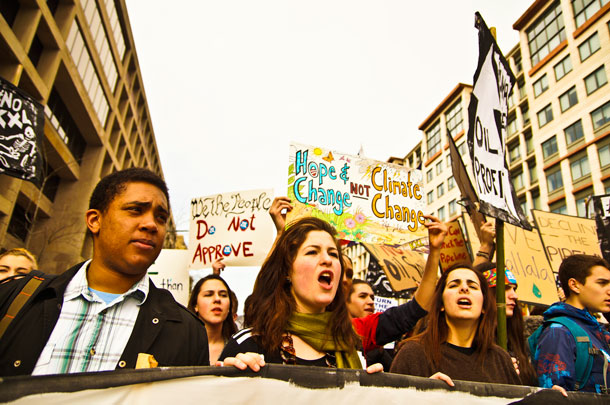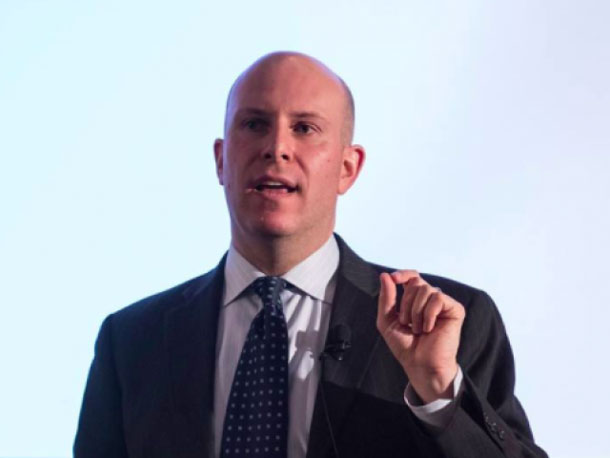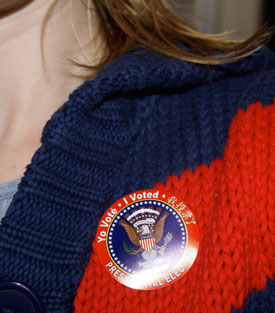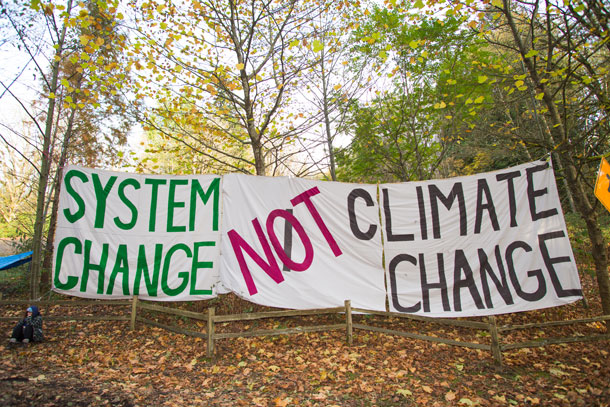The Environmental Voting Gap
Air Date: Week of December 7, 2018

The Americans who care strongly about the environment tend to be young, African American or Latino, and make under $50,000 a year. (Photo: Joe Brusky, Flickr, CC BY-NC 2.0)
Those US registered voters most likely to put the environment or climate as a top priority are young, African-American and Hispanic. But only about a fifth of these ‘super-environmentalist’ voters actually turned up at the ballot box to vote in the 2014 midterm elections, well below the national turnout rate. They came out in larger numbers in 2018 but still below national turnout rates. Environmental Voter Project Founder Nathaniel Stinnett joins Host Steve Curwood to discuss what it might mean for environmental policies if politicians tap into this base of some 20 million ‘super-environmentalist’ registered voters.
Transcript
CURWOOD: It’s Living on Earth, I’m Steve Curwood.
The 2018 Midterms resulted in the election of many environmentally-focused candidates for office at the national, state, and local levels. But to get re-elected, they may have to buck some tough demographics because a majority of registered voters who say the environment is a top priority for them didn’t bother to cast a ballot. To find out who these voters are, and why they might not be making it to the polls as often as other voters, we turn now to Nathaniel Stinnett, the founder and executive director of the Environmental Voter Project, based in Boston. He’s on the line now. Nathaniel, Welcome to Living on Earth!
STINNETT: Thank you for having me, Steve.
CURWOOD: First, your criteria. Tell us how do you determine if a voter is what you call an environmental voter?
STINNETT: So, we look for the real tip of the spear. We only target environmental voters if they list climate change or some other environmental issue as either their number one most important priority, or their number two most important priority. So, we're going after the real dyed-in-the-wool super-environmentalists. We've identified 20.1 million already registered super-environmentalists. The problem is, even though there are 20.1 million who are already registered, they don't always show up on election day.
CURWOOD: Now, I know you have numbers from the 2014 midterm, about these types of voters showing up. What are those numbers?
STINNETT: So, in 2014, only 4.78 million of those 20 million voters bothered to vote. So, the last midterm elections, 44 percent of registered voters showed up to vote, but only 21 percent of environmentalists. So, there's a big drop off.
CURWOOD: Now, it's fairly soon after the midterms and I'm sure you're still looking and gathering numbers. But so far, what do you see, to get the data on the 2018 midterms?
STINNETT: So you're right, we still are collecting a lot of data. However, we can glean a lot of very good information from exit polling data. So, this is polls taken of people after they left the polls on election day. And what we saw was that a stunning seven percent of voters listed the environment as the single most important issue facing the country. And seven percent might not sound like a lot, Steve. But that's three or four times higher than what exit polls saw just two or four years ago. We had 116 million people vote in these midterm elections in November. So, seven percent of that 116 million is over eight million voters listed the environment as the single most important issue. And that's a pretty big constituency.
CURWOOD: I know this isn’t apples to apples, but if you take this approximation with the data you have, from last time, roughly twice the number of environmentally focused voters came out.
STINNETT: That's right. It's not apples to apples. But clearly, the data shows that something is changing. Either more of our existing environmentalists turned out to vote, or there are some existing voters whose priorities are changing. Maybe they didn't care about the environment two years ago or four years ago, but now they care about it a lot more. There's definitely something changing.

Nathaniel Stinnett serves as Founder and Executive Director of the Environmental Voter Project. (Photo: Courtesy of the Environmental Voter Project)
CURWOOD: Alright, well, let's talk about this. What do you think kept them home?
STINNETT: You ask a really good question, Steve. And unfortunately, there's not an easy answer to it. But we do know is that people who are likely to really care about the environment are also more likely to be young, African American, or Latino. And those three groups that I just mentioned, historically, vote less often than the overall population. But that's only part of the story. What's really interesting is when we look just at Latinos, the ones who care about the environment vote less often than the other Latinos. Or if we look just at young people, the people who care about the environment vote less often than other young people. So, there's something else going on there. And the truth is, we don't know why these environmentalists aren't voting.
CURWOOD: Nathaniel, what's your best guess as to the one or two reasons that are really holding these environmental voters back?
STINNETT: I think part of what's going on here is that political campaigns are in the business of disenfranchising voters. And by that, I mean who you vote for, Steve, is secret, but whether you vote or not, that's public information. That's public record. And so the first thing any campaign does is they look at who votes and who doesn't vote, and they really only spend their time and money talking to good voters. And so right now, all these environmentalists who are saying, “oh, politicians don't care about me”… Well, they're absolutely right. If you have a public record of not voting, why on Earth would a politician care about you? And so I think what's going on here is that politicians make a very clear choice to not spend any time or money talking to, or caring about, people who don't vote. And environmentalists, by and large, don't vote.
CURWOOD: Interesting thought. Any other thoughts about what keeps the enviro-centric voter at home?
STINNETT: I think part of it also goes back to those demographic correlations that I mentioned. Environmentalists are far more likely than other people in the population to be African American, to be Latino, to live within five miles of an urban core, or to make less than $50,000 a year. And what this means is, environmentalists are much more likely to have voting barriers thrown up in front of them. And I think it's important that the environmental movement understand when certain states and certain counties make it harder for minorities or poor people to vote, that disproportionately affects our constituency. That's hurting environmental voters.

Instead of advocating for particular candidates, the Environmental Voter Project focuses on changing the voter base so that a larger number of environmentally conscious voters turn out to the polls. (Photo: ClatieK, Flickr, CC BY-ND 2.0)
CURWOOD: Nathaniel, one thing that you surprise me with in our conversation is that typically people point fingers at the big environmental organizations and say, where are the people of color? And yet, you're saying, those are the people who care most. How do you square that circle?
STINNETT: So, I'm not sure I do square that circle. I think you're absolutely right to point out that the leadership in certain environmental organizations - and I'll say the same thing about the Environmental Voter Project - we do not accurately reflect the constituency that we're trying to serve. I think most people when they imagine an environmentalist think about a yuppie, wearing Patagonia-fleeces, hopping out of their Prius in the suburbs. And maybe that was accurate 20 or 30 years ago, but it's not accurate now. A lot of studies show that the people who are disproportionately feeling the impacts of climate change and environmental degradation are - surprise, surprise - the people who care about it most on Election Day, and these are not wealthy white people in the suburbs. These are African Americans, these are Hispanics, these are people living in environmental justice communities, places where it's hard to breathe, and places that have power plants. These people are the new face of the environmental movement.
CURWOOD: People are looking ahead to 2020, looking ahead to who the Democrats might field. You've worked in political campaigns, you've advised folks from running for everything from city council to the United States Senate. What advice would you offer to any of the Democratic candidates for president, about tapping into what you see as a really underused resource, the environmental voter?
STINNETT: I would say that regardless of what people were seeing in their polls two years ago, or four years ago, the entire landscape has changed. And particularly, when you look at the people who are going to show up in a Democratic presidential primary, climate voters and environmental voters are going to be an enormous constituency. I would go so far as to say, Steve, that maybe 20 percent of the people who vote in the Democratic presidential primary could end up listing climate and the environment as either their number one or number two issue. So, this is an enormous constituency that could be mobilized if someone focused their messaging on talking about climate change. Bernie Sanders is hosting a town hall meeting just about climate change. You're seeing other people like Jay Inslee, Governor of Washington, thinking about running, and he talks about climate. You're seeing Jeff Merkley from Oregon who talks about climate all the time. A lot of people are talking more and more about climate change, and they see it as an advantage. And I just think that's an extraordinary thing to recognize, Steve. I mean, it was only two years ago that we had a whole series of presidential debates and climate change wasn't mentioned once.
CURWOOD: Not once.
STINNETT: Not once. And we're seeing that changing. And politicians aren't stupid. They're not going to talk about something that voters don't care about. So, the fact that so many people who want to run for president are now talking about climate change is a really interesting indication of where they think they can win.
CURWOOD: This may be fairly obvious to some people listening to us, but others may wonder, why is it important for environmentalists to vote?

The turnout of voters who list the environment as one of their top two priorities nearly doubled from the 2014 midterm to the 2018 midterm elections. (Photo: Mark Klotz, Flickr, CC BY 2.0)
STINNETT: Well, it's important for a few reasons Steve. One, obviously the more environmentalists who vote, the more environmental leaders we will elect. But beyond that, even if you live in a district or a state where you have an incumbent that isn't being challenged, or you live in a dark blue, or a dark red part of the country, it's still important for environmentalists to vote for one very clear reason, and that is this: whether you vote or not, is public record. And simply by voting, you become a first class citizen. Simply by voting, you become part of the unfortunately very small group of Americans who politicians pay attention to, because politicians - surprise surprise - don't care about the opinions of non-voters. They only care about the opinions of voters. So, by voting in every election - local, state and federal - you get to drive policy. You get to tell politicians, hey, look at me, look at my public voting record, I vote and that means you get to drive policy in this country. And that's something that we environmentalists can't pass up.
CURWOOD: Nathaniel Stinnett is founder and executive director of the Environmental Voter Project. Thanks so much for taking the time today, Nathaniel.
STINNETT: My pleasure. Thank you for having me, Steve.
Links
Introduction to the Environmental Voter Project
The Environmental Voter Project Website
The Guardian | “‘We Need Some Fire’: Climate Change Activists Issue Call to Arms for Voters”
Living on Earth wants to hear from you!
Living on Earth
62 Calef Highway, Suite 212
Lee, NH 03861
Telephone: 617-287-4121
E-mail: comments@loe.org
Newsletter [Click here]
Donate to Living on Earth!
Living on Earth is an independent media program and relies entirely on contributions from listeners and institutions supporting public service. Please donate now to preserve an independent environmental voice.
NewsletterLiving on Earth offers a weekly delivery of the show's rundown to your mailbox. Sign up for our newsletter today!
 Sailors For The Sea: Be the change you want to sea.
Sailors For The Sea: Be the change you want to sea.
 The Grantham Foundation for the Protection of the Environment: Committed to protecting and improving the health of the global environment.
The Grantham Foundation for the Protection of the Environment: Committed to protecting and improving the health of the global environment.
 Contribute to Living on Earth and receive, as our gift to you, an archival print of one of Mark Seth Lender's extraordinary wildlife photographs. Follow the link to see Mark's current collection of photographs.
Contribute to Living on Earth and receive, as our gift to you, an archival print of one of Mark Seth Lender's extraordinary wildlife photographs. Follow the link to see Mark's current collection of photographs.
 Buy a signed copy of Mark Seth Lender's book Smeagull the Seagull & support Living on Earth
Buy a signed copy of Mark Seth Lender's book Smeagull the Seagull & support Living on Earth

